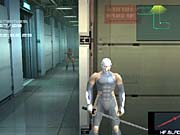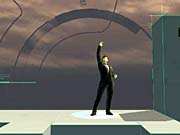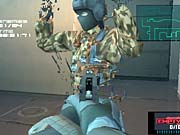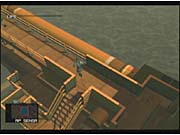Last year's release of Metal Gear Solid 2: Sons of Liberty for the PlayStation 2 was gaming's equivalent of the premiere of a huge Hollywood blockbuster. Anticipation for the game had grown extraordinarily high, both because it was a sequel to what's regarded as one of the best PlayStation games ever made, and also because a number of dazzlingly produced teaser trailers did an incredible job of whetting gamers' appetites for Metal Gear Solid 2's story and gameplay. People just couldn't wait to once again reprise the role of secret agent Solid Snake and infiltrate heavily defended enemy compounds using a combination of stealth and force, uncovering untold military secrets in the process. Upon the game's release, it met with glowing reviews from critics and was hailed as a superlative successor to its namesake--and yet players were shocked to find that Metal Gear Solid 2 turned out to have a huge twist: The main character in fact wasn't the coolheaded Solid Snake, but an entirely new character, an inexperienced young soldier called Raiden--a Luke Skywalker to Solid Snake's Han Solo.

Just as with many Hollywood blockbusters, now that the excitement over the game's release has dissipated, it's become fashionable to speak ill of Metal Gear Solid 2: Sons of Liberty. Suddenly more gamers out there seem to think Metal Gear Solid 2 was a complete letdown, while at around the time of the game's release, these same people were calling it the greatest game ever made. Social commentaries aside, it's perfectly understandable that the game's heavy-handed, convoluted, arguably sloppy story has been the object of much criticism now that it's had a while to sink in. Also, most all Metal Gear Solid 2 players like to point out that they just hate Raiden. With all of that said, it's difficult to look at the newly released Metal Gear Solid 2: Substance as an entirely new game, because in one sense it isn't, and in another sense it is.
Essentially, Metal Gear Solid 2: Substance lets Xbox owners experience one of the most talked about games ever made. It also throws in a number of additional features, most notably a series of no fewer than 500 so-called VR training missions that let you explore the nuances of Metal Gear Solid 2's gameplay without all the cinematic trappings. Unfortunately, it's plain to see that Konami didn't spend a lot of time translating Metal Gear Solid 2 to the Xbox. The game wasn't optimized for Microsoft's technically superior platform, at best looking equally as good as the year-old PS2 game, and at worst suffering from some technical issues that weren't in the original. So Metal Gear Solid 2 fans that own an Xbox as well as a PS2 will be disappointed that this version of the game isn't hands-down superior to what they've already played. On the other hand, Xbox owners who've never played Metal Gear Solid 2 will find in Substance a highly intriguing, original action game with some truly impressive production values and considerably more lasting value when directly compared to last year's version.
As mentioned, the core of Metal Gear Solid 2: Substance is in fact just Metal Gear Solid 2: Sons of Liberty. The game consists of two parts, the first being a relatively short sequence in which you play as Solid Snake, and the second being the main portion in which you play as Raiden. Very story-driven and mostly linear, Metal Gear Solid 2 is by all means a cinematic game, one that you simply sit back and watch almost as often as you actually play. Much of the story unfolds via one-to-one conversations between the game's main characters using a communications device called a codec. Here you just see a green-tinted screen with close-ups of the speaking characters' faces, and you listen to (or read) what they have to say. At other times, Metal Gear Solid 2 presents some extremely impressive noninteractive cutscenes using the game's 3D engine, which look like something out of a big-budget action movie, only with video game characters instead of real people. These of course are much more interesting than the codec sequences, although the game's story does remain engaging if you're willing to keep up with it through a few very strange plot twists.

The actual gameplay involves lots of things: sneaking around, exploring, shooting with a variety of different real-world weapons, going toe-to-toe with some interesting and challenging bosses, and numerous other small but clever elements. The action appears highly realistic--some surprisingly lifelike enemy behavior, outstanding animation, and lots of little details make Metal Gear Solid 2 one of the closest video game approximations to superspydom that there's ever been. But at its heart, Metal Gear Solid 2 is still an action game, and the game's designers, with tongue in cheek, borrowed a few classical gaming conventions: For example, at the normal difficulty setting, you can withstand an inordinate amount of gunfire before finally perishing. You can instantly restore your health just by eating rations, and guards are curiously nearsighted, unable to detect you if you stand about 30 feet away. On the other hand, the game's authentic touches, such as how depleted ammunition magazines can be thrown to distract enemy guards, can be really impressive. Even still, Metal Gear Solid 2 isn't exactly a simulation of being a secret agent, and Xbox owners looking for a more believable spy game may be better off holding out for Tom Clancy's Splinter Cell.
Substance controls fairly well on the Xbox once you get used to it. If you've played a lot of first-person shooters, you may initially be thrown off by how the game constantly requires you to switch between a top-down third-person perspective and a first-person view. The catch is that you can't aim precisely from a third-person perspective, but you have to stand still when in first-person mode. So you'll often sneak up behind guards, switch to first-person view, and then quickly shoot them in the head either with deadly ammo or with tranquilizer darts if you're feeling humane. Toggling first-person view is achieved by clicking in the left analog stick, which is also used for moving around, so it's possible to become very disoriented by depressing the stick by accident. Nonetheless, you should get a feel for the controls with a little practice and soon be able to sneak up, point, and shoot effectively.
Snake and Raiden have numerous other moves. They can strangle unsuspecting victims or use them as human shields, they can hold up their victims by surprising them with a gun to their backs, they can execute hip tosses or punch and kick combos, and they can leap away from (or headlong into) their foes. Also, what with the game's great variety of pistols, assault rifles, explosives, and high-tech gadgets such as thermal goggles and a long-range microphone, Metal Gear Solid 2 definitely affords you with a lot of cool stuff to use and a number of cool situations in which to use it.

The core game is about 15 hours long the first time through, assuming you don't skip over the plot (and you shouldn't), plus there's some inherent replay value in it. For one thing, the story rewards multiple viewings, since you'll invariably miss some of the rapid-fire details the first time through. Tougher difficulty settings make the artificially intelligent guards much more ruthless and disable your tactical radar display, the absence of which makes playing the game very different and a lot more challenging. You can also fight your way through the game's sequences using a variety of different tactics, uncover numerous amusing secrets, and unlock some hidden extras by sneaking up on and sticking up all the guards you'll encounter, shaking them down for their dog tags and collecting these as you go along. It's a fun little meta-minigame.
Early reports stated that Metal Gear Solid 2: Substance would allow players to experience Raiden's chapter of Metal Gear Solid 2 from the perspective of Solid Snake, and that turns out to be partly true. One of the extras in Substance is the addition of five small, new missions called "Snake Tales," each starring Snake and each taking place during the events of Metal Gear Solid 2. These are balanced for experienced players and can be played in any order, but compared with the lavishly produced main game, these new missions seem rather disappointing. Cinematic cutscenes are replaced with pages of onscreen text, and there's no new voice-over, so the additions to the storyline in these new missions seem unnatural and slapped together. Nevertheless, they're certainly a chance to play more of the game from the perspective of Solid Snake.
The VR missions are more compelling and offer a great variety of increasingly challenging tactical situations for you to solve. The main plot of Metal Gear Solid 2 makes numerous references to Raiden's VR training, so it's great to finally see exactly what he's had to go through (though fans of the original Metal Gear Solid will remember that game's similar VR training missions). In these stylized scenarios, you'll master all the game's different weapons, sneak through numerous difficult situations, and practice holding people up, taking people out, and moving precisely. You're rated based on your performance in each of these stages, and if you score well enough you get a code that can be used on Konami's official Web site to compare your standings against those of other Substance players.
As you finish more and more missions, you'll gain access to hidden characters and their own unique sets of VR missions. Generally, some of the best mission types are the "alternative missions" for each character, which are unlocked once you finish with the basic missions, and they tend to be quite creative and enjoyable. For instance, one has you running through a nearly pitch-black, enemy-infested area with nothing but a ninja sword and the goal of defeating everyone in the level. Also, some of the elimination missions are a lot of fun, as they provide you with numerous weapons but limited ammo, forcing you to take out a bunch of foes quietly, accurately, and strategically.
One year later, Metal Gear Solid 2 is still one of the best-looking PlayStation 2 games, but the Xbox's graphical capabilities are held to a higher standard. The game's meticulous attention to detail and its superb motion-captured animation are imported intact to the Xbox, but some instances of noticeable graphical slowdown now mar what was a consistently smooth gameplay experience on the PlayStation 2. The frame rate problems are rare but sometimes occur in high-intensity situations such as during certain action-packed cinematics or when you're being swarmed by enemies, so these issues don't just affect the graphics, but can also hurt the gameplay experience a bit. Nevertheless, Metal Gear Solid 2: Substance is still a great-looking game, filled with memorable characters and realistic effects.

The game's audio is even better, thanks to some very good voice acting and especially due to Metal Gear Solid 2's terrific, catchy musical score composed by Harry Gregson-Williams, who provided similar music for big-budget action movies such as The Rock. If the game's cutscenes don't make you feel like you're taking part in an epic thriller, then the music most certainly will. It interactively changes depending on the situation and will make the game's suspenseful bits all the more so and the game's intense bits all the more so. The rest of the game's audio is also very well done, from all the different-sounding firearms to smaller touches like the sound of seagulls off the coast of the game's main setting of a mysterious deep-sea production plant. Those with Dolby Digital setups should especially enjoy listening to Substance.
It's true that Metal Gear Solid 2: Substance isn't as big of a deal as last year's game, since it's basically last year's game rereleased a year later. But despite the backlash against Metal Gear Solid 2's wild story and main character, one year later, it's still a great game that isn't comparable to anything else that's out there. So, simply put, if you haven't played Metal Gear Solid 2 before, go for it now. The extras in Substance--while perhaps not as substantial as Metal Gear fans had hoped--help make the wait for this Xbox version justifiable, but in the end, it's the core game itself that's still very worthwhile.